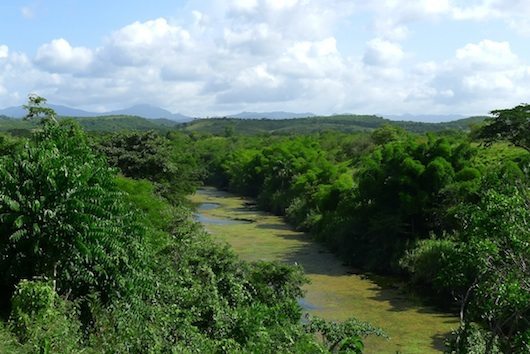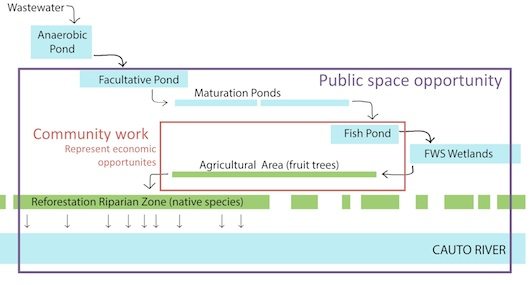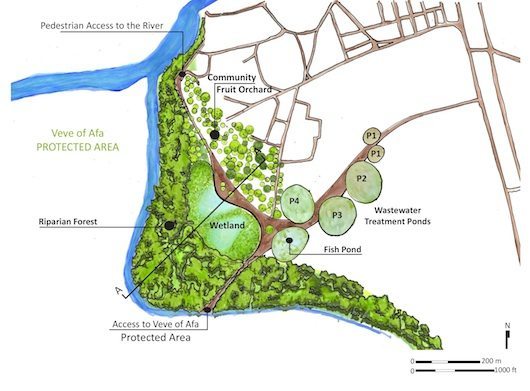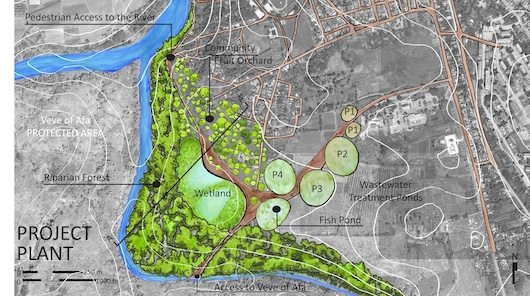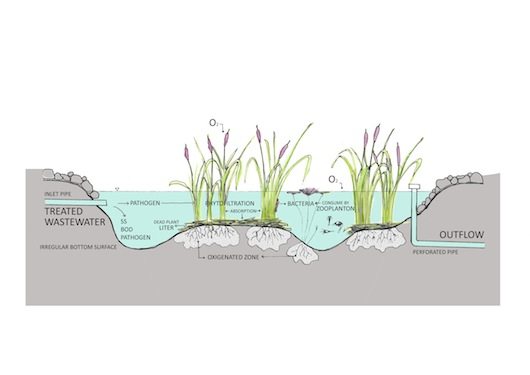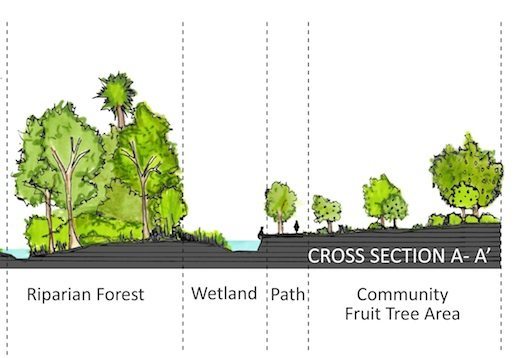In This Issue
-
Jourdan Imani Keith ● Your Body
-
Jackie Brookner ● Valuing Dirt + Water
-
Stacy Levy ● Working Earthworks

-
Daniela Corvillon ● Wastewater In Cuba
-
Linda Weintraub ● Tragedy of Wild Waters
-
Chris Drury ● Heart of Reeds
-
Betsy Damon ● 25 Years On Water
-
Basia Irland ● The Ecology Of Reverence
-
Suzon Fuks ● Waterwheel, Women & Collaboration
-
Susan Leibovitz Steinman ● DIRTY WATER
Wastewater Treatment Project Proposal
DESCRIPTION
This project is based upon an investigation as to how cultural identity can be a social trigger to address ecological degradation. The research methodology draws from environmental, social and urban analyses in order to unveil the best strategy to address the ecological, river restoration and water treatment challenges in the city of Palma Soriano in southeast Cuba.
The project aims to promote the strength and capacity of local communities to protect their own environment based upon a master plan, which includes natural wastewater treatment, reforestation and the facilitation and utilization of a public space bordering the major river which flows along Palma Soriano, the Cauto. This project will contribute and produce healthy water recycling for the City of Palma, providing a potable water source for the city and ecological restoration of the riparian zone of the Cauto. It is designed to preserve the cultural identity and sacred spaces of the local community and to restore the essential balance between the community’s need to sustain both itself and the natural environment.Â
I. Â BACKGROUND
I got involved in this project because of my interest in local cultures with strong spiritual ties to their environment.  I began work in 2011 with ENNEGRO in Palma Soriano through my professor Matt Kondolf at UC Berkeley, who introduced me to the community and its potable water problems. Profesor Kondolf works in river restoration and he was approached in 2003 by Maria Ayub, who did her Landscape Architecture thesis at Florida International University in Miami, Florida.  He visited Palma with Maria because of the connection of the Berkeley-Palma Soriano Sister City Association to the project.
ENNEGRO is an Afro-Haitian Cuban environmental art group which based a sacred relationship between ecology and religion in their project The Vevé of Afá. The Vodou religion is known for giving spiritual values to the landscape. Its followers believe that ancestor spirits and gods live in the native forest. It is extremely important for them to keep rivers and streams clean and in continuous movement.
ENNEGRO made progress ten years ago, when the Cuban government gave them a site deemed sacred in their practice of Vodou at the intersection of the two rivers which form the Cauto, located just upstream from the City of Palma Soriano, where Maria Ayub did her thesis research and offered a possible proposal in design. They have an extensive plan for a land art project but not the financial support to build it.
Moreover, the poor urban conditions of Palma Soriano are destroying the ecology in a worsening cycle. The ecosystem of the Cauto River is extremely polluted with the continual flow of sewage into the river and the on-going deforestation of the surrounding area for firewood. The firewood is used in cooking and to boil water to make it potable. The only water source is from the contaminated Cauto River. We would change this pollution and integrate human water uses into the natural cycles. My goal is to help Palma Soriano restore the ecological balance and improve water quality.
A short film on Palma and the project has been produced by Green Cities Fund  to illustrate the problems and the goals. It can be seen at:
In Cuba, agricultural exploitation since the 18th Century has left a profound impact on the local landscape. Consequences of this exploitation have been the loss of nearly 87.5% of island’s forest (Scarpaci & Portela, 2009), and the uncontrollable desertification of the watershed of the Cauto River in Eastern Cuba.
The Cauto River is Cuba’s longest river, with a length of 230 miles. The Southeast part of the Cauto River watershed supports one of the most vulnerable communities on the Island, the Afro Haitians, whose citizenship was recognized only after the 1959 Revolution. This community migrated to this area to escape slavery in Haiti and has continued in subsequent migrations.
The city of Palma Soriano is located in the upstream watershed of the Cauto.  It is the biggest city in the Cauto watershed, with approximately 124,000 habitants.
II. THE PROBLEM
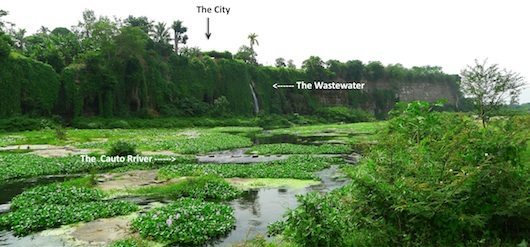
Principal Problem: The wastewater run-off from the city of Palma Soriano directly to the Cauto River.
Cauto River urban settlements are contaminating their water sources, especially with respect to the city of Palma Soriano, where raw sewage flows directly to the Cauto River. The rudimentary conditions of the urban area have resulted in the contamination of the Cauto. Raw sewage from the city goes directly to the river, contaminating the water and producing a continued degradation of the ecosystem around it, affecting the surrounding communities. The Afro Haitian community of Palma Soriano is especially concerned about the degradation of water quality in the Cauto River and they have asked for international support.
The local problems provide an opportunity to develop design solutions that integrate social and environmental issues for a community in need of help. This problem has led to several damaging consequences not only to the environment but also to the health of the population, as the river is both the source for potable water and simultaneously the sink for waste water. Following Hurricane Sandy in 2012, numerous outbreaks of cholera occurred.
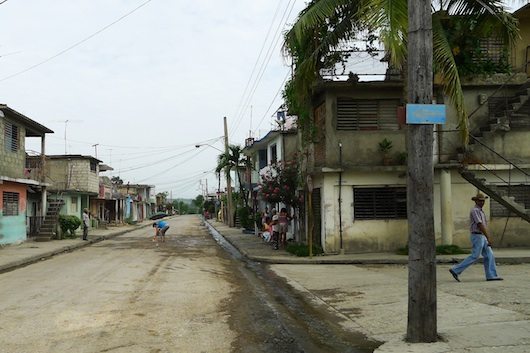
Palma Soriano July, 2012. The urban area of Palma Soriano is characterized by the poor sewer conditions. This photo shows how wastewater flows into small open canals in streets. This type of system is very unhealthy and is a source of malaria and cholera spreading in the city. Children are specifically affected by this as they play in streets almost all day long.
The polluted drinking water has caused the spread of disease and in some cases deaths within the community. Many community members treat the polluted water by boiling it before consumption. Wood is collected from the riparian forest of the Cauto River for fuel. As a result of decades of this process and of high agricultural production, the Cauto River watershed is now severely deforested. The deforestation of the Cauto River watershed has led to an increase in sediment input and the degradation of the river’s ecosystem. It is very difficult to control the illegal deforestation, and this practice will likely continue if no alternative is provided. Treating the discharge into the river will improve the quality of drinking water for the community and mitigate the need to deforest the riparian forest.
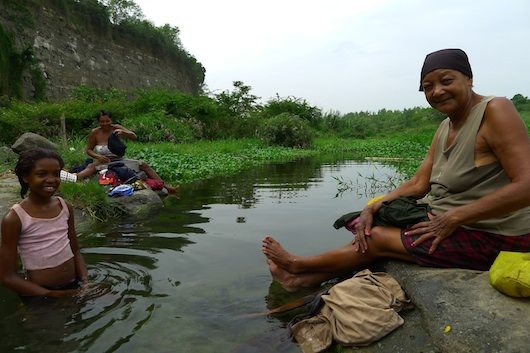
Cauto River is the principal green public space of the city and supports the daily life of thousands of people. (Woman doing laundry)
It is crucial to resolve the problem by providing treatment for waste -water before it returns to the river. Conventional water-treatment facilities are multimillion-dollar, highly engineered facilities. They are designed with minimal regard to their environmental impact and their dependence upon energy and raw materials. These systems generate byproducts and pollutants during treatment (e.g. waste sludge, waste gases, and waste chemicals) and have a high operational cost (Yang 2006). The environmental byproducts and cost make it difficult and almost impossible to implement such facilities in Palma Soriano, where the cost and consumption of energy should be held to a minimum.
III. PROPOSAL SOLUTION
This project has two main goals: 1) to create a waste water treatment system for the city of Palma Soriano, and 2) to integrate the community with the project. A pond system and a constructed wetland will be used to treat the city’s waste water.
The waste water treatment system has multiple benefits. One component of the waste water treatment design is a reforestation project. As part of the tertiary system, the treated water will be used to irrigate riparian vegetation and fruit trees. The riparian vegetation will provide habitat for wildlife and improve the ecology of the watershed. The fruit trees will provide additional habitat for wildlife as well as provide a source of food for the community.
An additional component of the waste water treatment system is an aquaculture pool. After the waste water has been treated, the water will be directed into a pool that can be used for aquaculture. The community will be in charge of maintaining this system and can use the aquaculture as a source of food for their pigs, the main source of livestock consumed in the community.
To ensure the community’s engagement, the community will be involved in refining the final design, constructing the project and managing the system. The fruit orchard and aquiculture system will provide an additional incentive for the community to become involved in maintaining the system.  If successful, communities both in Cuba and elsewhere can employ the project’s low cost, yet effective methods.
IV. THE MASTER PLAN DESIGN
The master plan proposal integrates all the proposed solutions into one overall project. It is extremely important to view this proposal in a holistic manner, as the relationship between individual portions of the plan must be maintained in order to accomplish the ultimate goal. Each part could be seen as an independent project; however, this approach would actually stress the system. Overall success and function of individual components truly depend on implementation of the entire master plan. As you will see, the master plan provides a macro scale solution for the city of Palma Soriano. This includes a new source of up-steam water and a new sewer system that permits drainage of waste water to an area that will provide natural waste water treatment. The new source of up-stream water and a new sewer system are part of the future plan of the municipality of Palma Soriano, under the proposal of “Saneamiento y Sanitisacion para Palma Soriano”.
The area of natural waste water treatment proposed in the master plan is divided into three stages of treatment: primary (a sedimentation and facultative pond), secondary (maturation ponds) and tertiary (a fish pond and constructed wetland). Treated water will be use for irrigation at a community farm and in the proposed reforestation area. Finally, the master plan locates and designs a pedestrian path that integrates the project into the surrounding area and provides an element of human experience. It is important to note that this master plan is a sketch design project that needs to be reviewed and modified by local professionals and participants from the surrounding communities.
V. PROJECT PARTS
1. New Source of Water Upstream
The city of Palma Soriano needs to access an upstream source of water. The primary objectives of this new water source will be to provide the city with fresh water and a continuous flow.
2. New Sewer System
The city of Palma Soriano needs to update their old sewer infrastructure and extend sewer service areas to the entire urban area. This expansion will control excess wastewater draining into the river and streams. The alignment of the pipe system is based on the natural slope-drainage and provides sewer services without requiring complex engineering solutions. To that end, the project includes a design of a new sewer system for the city.
3. Natural Waste water Treatment
From the base of the sewer system and the water coming in from serviced areas, it is possible to design a natural treatment system that digests organic matter through the biological process of degradation. In order to develop this water treatment it is very important to accurately project the volume of water that will be treated. Since this data is not available for Palma Soriano, our calculations (e.g. water volume and water retention time) are based on reference values from cities with similar characteristics (e.g. Lima, Quito, Bogota, San Francisco and Barcelona). We also used data provided by WHO and UNICEF.
From the water calculations, my results show a series of four ponds. The pond system is a very effective way to clean the water and does not need high levels of maintenance.
The first two ponds function to encourage sedimentation of solid sediment and start the process of organic composition that is the function of the next two maturation ponds. The shallow depth of the pond will allow more sun light penetration to the water and facilitate photosynthesis from the algae.
4. Fish Pond
After the sequence of maturation ponds, a fishpond would generate an aquaculture. Aquaculture techniques are used to feed populations without taxing natural fish populations. A fish pond that can be managed by the local community gives them products from water treatment, integrating economic opportunity for the community and an essential food source.
5. Constructed Wetland
The final element of the proposed master plan involves the construction of a wetland area. Wetlands are beds of aquatic life that grow in soils or, more commonly, sand or gravel. They provide wildlife habitat and have a strong capacity to support nesting and feeding of birds. The principal species proposed are based on native, non-invasive species in Cuba. Finally, the design and area of the wetland should integrate not only wildlife and hydraulic functions, but also include an interesting design that permits interaction of people with the place and engagement of people with the wastewater system.
6. Community Fruit Orchard
An additional element was added in order to construct a space for the community and to direct effluent water from the treatment system towards locally supported agriculture. This designated are will be a community fruit orchard. This treated wastewater has high levels of nutrients and is therefore appropriate for irrigating agricultural fields. I believe that the integration of fruit production into the project will incentivize the local community to participate and at the same time will help to show the importance of caring for the environment. Community involvement in this project will allow locals to understand how their food needs and waste disposal practices can be intricately linked to the surrounding ecosystem.
7. Reforestation Area
The plan proposes to irrigate an area of low dense forest and deforested patches in order to restore the Cauto River’s native riparian forest. This area is located on the border of the river and the reserve area – Veve de Afa. The native riparian forest restoration project will restore the native ecosystem of the river, create a barrier between the urban area and the protected area, and provide open space to the local community.
8. Design the PathAccess to the River and Public Spaces
By capitalizing on the opportunities associated with the wastewater treatment system and designing it with access and public spaces in mind for people to interact with the area, the project will encourage community participation with the treatment system and surrounding ecosystem.
VI. CONCLUSIONS
Creating equilibrium between societies and the environment is not easy. Water management is an essential factor in sustainable development. A natural water treatment system improves not only the quality of the water discharged but also the quality of life for the surrounding community.
The master plan proposed and toolbox provided are essential elements to help initiate this project. With the participation of international NGO Green City Foundation in Oakland, California, and the high interest of the community, this project is moving to the next stage of development. Today we are working together with the local government and the planning department of eastern Cuba to make this project a reality. There are several stages that need to happen and monetary funding needs to be finally granted. Working from abroad is not easy and the process and changes are slow to come by. It is extremely important to educate the community and engage them in the development of the project. We have not started the construction of the project yet, but we are receiving a lot of interest of other groups.
END NOTES
1 Source: Instituto de Geografia de la Academia de Ciencias de Cuba y el Instituto de Geografia y Cartografia, Academia de Ciencias de la URSS 1970.
REFERENCES
Drechsel, Scott, Raschid-Sally, Redwood & Bahri, (2010). Wastewater Irrigation and Health: Addressing and Mitigating Risk in Low-Income Countries. London: Earthscan Dunstan House
Marrero Baez, Yociel (2008). Estudio de las Eco tecnologÃas para el Tratamiento de Aguas Residuales en Zonas Urbanas. Instituto Superior Politécnico José Antonio EcheverrÃa, La Habana 26.
Scarpaci, Joseph L. and Portela, Armando H. (2009). Cuban Landscapes: Heritage, Memory and Place. New York, The Guilford Press
United Nations General Assembly (2000). United Nations Millennium Declaration. Resolution A/RES/55/2. New York, United Nations
Yang, Jo-Shing (2006). Solving Global Water Crises: New Paradigms in Wastewater and Water Treatment. California, Earth EcoSciences Publishing Company.


